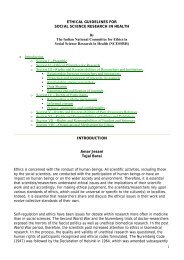H O S P I C E
H O S P I C E
H O S P I C E
You also want an ePaper? Increase the reach of your titles
YUMPU automatically turns print PDFs into web optimized ePapers that Google loves.
H O S P I C E<br />
A Compassionate Service
THE HOSPICE MODEL
Utilizes a team-oriented approach to medical<br />
care.
Offers excellent pain management and symptom<br />
control
Offers physical, emotional and spiritual support to<br />
the patient/family
Support Is tailored to each patient’s unique needs
Relies heavily on the support of many trained<br />
volunteers
Compassionate Bereavement support is offered to the<br />
patient’s family or loved ones for at least a year after the<br />
death of the patient.
Type and Number of Hospices in<br />
the USA in 2010
Free<br />
Standing<br />
2278<br />
Home Health<br />
Agency<br />
Based<br />
578<br />
Hospital<br />
Based<br />
531
Free Standing Hospice<br />
A Free Standing Hospice is independently owned<br />
and offers complete hospice services – Home<br />
Care, Inpatient Care and Bereavement Support.
Home Health Agency Hospice<br />
Owned by a Home Health Agency, usually for-profit,<br />
and they contract with a free standing hospice or<br />
hospital based hospice for inpatient services.
Hospital Based Hospice<br />
Provides a small designated inpatient unit or selected<br />
scattered inpatient beds with a palliative care team<br />
that services the entire hospital. The hospital will also<br />
have a small home care agency to provide home care.
US Government mandates ALL hospice<br />
care MUST be primarily home care<br />
with limited use of inpatient beds.
In the UK and Ireland vast majority of hospice care<br />
provided in free standing hospice inpatient building.
Free Standing Model of Hospice<br />
My talk today will be focus on the Free Standing<br />
Model of Hospice Care.
Here is a picture of two free standing hospices that are<br />
very different from each other.
The Hospice at the Texas Medical<br />
Centre, Houston, Texas
The Hospice at the Texas Medical Center, also known<br />
as Houston Hospice, was founded in 1980 and was<br />
one of only 4 hospices in the United States at that<br />
time.
It has a large home care service that offers hospice<br />
care to over 200 patients a day.
Medical students and Residents from Baylor College<br />
of Medicine and from University of Texas Medical<br />
School rotate through the hospice as do nursing<br />
students from 3 nursing schools, social workers from<br />
2 universities, and ministers from the community.
Zen Hospice Project<br />
San Francisco, California
Zen Hospice Project was founded in 1987 as a service<br />
offered by the monks and students at the San<br />
Francisco Zen Center. Initially, it brought services to<br />
indigent cancer patients living in the streets or in<br />
small residential hotels. Soon after, the AIDS epidemic<br />
came to the forefront in San Francisco.
It was the first Buddhist Hospice in America.
In 1988, Zen Hospice Project began working in<br />
partnership with Laguna Honda Hospital to offer<br />
hospice services in an institutional setting.
Zen Hospice started offering person-centered care for<br />
the dying at its residential Guest House, a renovated<br />
Victorian Home across from the Zen Center, in 1990<br />
and incorporated formally as Zen Hospice Project in<br />
1992.
Over the years, it has become a haven for people who<br />
are dying and their families, who had nowhere else to<br />
turn.
8 Reasons for the Popularity of the<br />
Free Standing model of hospice<br />
Care
1<br />
They only do hospice and palliative care. This means<br />
they are never distracted by being part of a cure<br />
oriented environment
2<br />
The entire building is designed to be very<br />
homelike and comforting with each patient room<br />
carefully decorated to be more like a room in<br />
your own home.
Patient Room
Hospice Social Area
3<br />
There are gardens accessible for patients, families, and<br />
staff to rest in and enjoy the flowers, birds, and trees.
Entrance to Garden
Garden area
Fountain in Garden
Azalea Garden
4<br />
Pets are allowed to visit in the hospice and many free<br />
standing hospices have a cat or dog or both that live<br />
there and are free to roam from room to room. They<br />
are called “Therapy Pets”.
5<br />
All the staff are there because they have chosen to<br />
work specifically with the dying and the bereaved.
6<br />
All the staff – administrative, medical, pastoral, and<br />
volunteers are all trained in care and support of the<br />
dying/bereaved and see the dying (death) as our<br />
greatest teacher.
7<br />
Because there are no emergencies in hospice there is<br />
a great sense of peacefulness and openness in a<br />
hospice environment.
8<br />
This view leads to profound and life changing insights<br />
into the development of compassion and<br />
unconditioned love.
The Hospice Inter-disciplinary<br />
Team<br />
The Hospice Interdisciplinary Team is the most<br />
important component in a hospice. How the team<br />
functions together can make the difference between<br />
an excellent hospice and a mediocre hospice.
When a hospice is small The Hospice Team IS the<br />
Patient Care Team.
The Patient Care Team<br />
Hospice<br />
Physician<br />
Bereavement<br />
Coordinator<br />
Hospice<br />
Nurse<br />
The Patient &<br />
Family<br />
Volunteer<br />
Coordinator<br />
Clinical Social<br />
Worker<br />
Hospice<br />
Chaplain
When the hospice grows larger The Hospice Team will<br />
be made up of the directors of each disciplinary area.<br />
This team will usually meet once a week.
The Hospice Team<br />
Hospice<br />
Administrator<br />
Volunteer<br />
Coordinator<br />
Medical<br />
Director<br />
Patient & Family<br />
Pastoral Care<br />
Director<br />
Nursing<br />
Director<br />
Social Work<br />
Director
The Patient Care Team will meet every day. As the<br />
hospice grows larger there may be many Patient Care<br />
Teams within the hospice. Each team will cover a<br />
specific geographic part of the service area.
The Role of Each Team Member
The Administrator<br />
The role of administration on the team is that of the<br />
enabler. They must understand the needs of<br />
patient/family and caregivers and develop ways to<br />
find and maintain whatever is needed to meet the<br />
needs of both staff and patient.
Hospice Physician<br />
The head of the medical component of patient<br />
care team is always the physician. The physician<br />
will treat patients in the Patient Care Centre and<br />
will also make house calls if a patient is being<br />
supported in their own home.
Hospice Physician with Patient
Hospice Nurse<br />
The Hospice Nurse is highly trained in palliative<br />
care and works with the hospice physician as well<br />
as with the other team members.
Clinical Social Worker<br />
The Clinical social worker works closely with<br />
patient/family dynamics and aids other members<br />
of the team in discussions on how to deal with<br />
certain situations that may arise or that have been<br />
on-going within the family.
Chaplain<br />
The Chaplain is available to patient/family if they<br />
request spiritual support. The chaplain is also<br />
available to staff members. Staff can become<br />
closely involved with their patients and tend to<br />
accumulate grief from the loss of all of the<br />
patients in their care.
Volunteer Coordinator<br />
Hospices rely on the help of many, many trained<br />
volunteers. We use volunteers to help in the<br />
office, as well as in patient’s homes and in the<br />
Patient Care Centre. They do everything from<br />
sitting by the bedside of a patient for hours,<br />
reading to patients, running errands, flower<br />
arranging, as well as help with fund-raising.
The Bereavement Coordinator<br />
The bereavement coordinator steps in after the<br />
death of the patient. Hospice continues to<br />
support the family and loved ones for at least a<br />
year after the death of the patient. We have<br />
trained bereavement volunteers that work with<br />
the bereavement coordinator to give support<br />
wherever and whenever it is needed.
How the Hospice Team Functions
Meets daily to discuss patients needs – physical,<br />
emotional, and spiritual. Also helps to ensure<br />
that team members do not bring their own<br />
emotional baggage into the care of the patients.
Physical pain can be powerful and dehumanizing, and<br />
can create tremendous stress within the family. This<br />
makes it important that we deal with their pain<br />
immediately.
The medical component is the largest part of the<br />
interdisciplinary team. Daily team meetings help to<br />
ensure that hospice care remains balanced with the<br />
emotional and spiritual support remaining as strong<br />
as the medical support.
Admission of a Hospice Patient
All Patients must have a referral from a physician with a<br />
prognosis of 6 months of less to live.
An appointment is made with patient/family to discuss hospice<br />
care and to have admission form signed and witnessed.<br />
The admission form states the prognosis and has a Do Not<br />
Resuscitate statement.
Home Care<br />
Admission:<br />
• If it is a home admission patient is to be<br />
cared for in their own home.<br />
• Hospice nurse and social worker explain<br />
hospice care to patient/family.<br />
• Forms are always read aloud and then<br />
signed by patient/witness. Copy left it<br />
home.<br />
• Nurse does physical exam of patient and<br />
social worker talks with family.
When<br />
they<br />
return<br />
to the<br />
office:<br />
• If patient needs pain/symptom management<br />
hospice physician is scheduled to make a house<br />
call.<br />
• The nurse orders any medical equipment<br />
needed in home. If medication is required it is<br />
ordered and delivered.<br />
• Nurse and social worker meet with the team to<br />
discuss and make plan of care and schedule<br />
visits.<br />
• Referring physician is notified of admission by<br />
hospice physician
Patient<br />
Care<br />
Centre<br />
Admission<br />
• Hospice physician/nurse make visit to patient’s<br />
home or hospital room and explain hospice<br />
service, have forms signed/witnessed.<br />
• Physician evaluates medical needs of the<br />
patient.<br />
• Time of admission to PCC is determined and<br />
ambulance transport scheduled. No sirens or<br />
flashing lights.<br />
• Patient arrives in ambulance, is greeted at front<br />
door by nurse and taken to room.<br />
• Shown social areas, nurses station and meet<br />
various member of hospice team
Hospice accept all patients who are referred to us with<br />
the required prognosis no matter what their financial<br />
condition is or whether they have insurance or not.
Hospice Volunteer Program
Volunteers are an important part of the<br />
interdisciplinary team working to “de-institutionalize”<br />
the dying process and to help provide a more humane<br />
system of care for the dying and their families.
Federal law requires that at least 5% of all hospice<br />
patient care hours be provided by volunteers.
Volunteers offer many important services including:
Support for patients: This can include visiting, reading,<br />
taking walks, writing letters, bringing in music,<br />
supervising visits with pets, even massage therapy for<br />
volunteers with the necessary skills
Respite and support for family members: Volunteers<br />
can assist with shopping or household maintenance,<br />
or allow family caregivers the opportunity to take<br />
care of necessary errands and get some time away<br />
from the house. Family members also appreciate a<br />
visit from a compassionate friend who understands<br />
what they are going through
Child care assistance: This can include help with<br />
babysitting, picking up children from school or<br />
providing necessary transportation to club meetings<br />
or sporting events and practices. Volunteers have also<br />
made invaluable contributions with family pet care.
Bereavement support: Hospice volunteers can work<br />
closely with the hospice’s professional bereavement<br />
staff in duties that range from assisting as a support<br />
group facilitator to serving refreshments and helping<br />
with mailings to clients and families.
Fund-raising and administrative work: A volunteer<br />
with clerical skills can serve a hospice by helping in<br />
the office with simple administrative duties.<br />
Fundraising responsibilities can range from preparing<br />
mailings or thank you letters to organizing fundraising<br />
events and contacting possible donors.
To ensure that all volunteers are equipped for the<br />
challenge of working with the dying, hospices require<br />
that volunteers complete extensive orientation and<br />
training sessions, as well as submit to a routine<br />
background check. It’s important that volunteers<br />
understand the history of hospice and are aware of<br />
the specific ways their local hospices works to serve<br />
the community.
DEATH OF A PATIENT
When a patient dies in hospice care we use “ritual” to<br />
help ease the sense of loss of a loved one.
Home<br />
Care<br />
Death:<br />
• We encourage close family members to<br />
take part in washing and cleansing the<br />
body.<br />
• Light candles and burn incense.<br />
• Prayers and/or meditation as they wait<br />
for the removal of the body
Patient<br />
Care<br />
Centre<br />
Death:<br />
• Family members and patient care staff<br />
wash and clean body.<br />
• Light candles and burn incense in patients<br />
room and allow family to sit quietly until<br />
arrangements have been made to<br />
remove body and/or until their religious<br />
requirement have been met.
Patient Care Centre Ambulance<br />
Entrance
Once body has been removed the room is cleaned and<br />
the bed is made.<br />
We then lay a rose on the pillow of the bed and no new<br />
patient is admitted to this room for at least 24 hour.
BEREAVEMENT
Hospice is mandated to provide bereavement support<br />
to family and loved one for at least one year after the<br />
patient’s death
The Bereavement Coordinator has a team of trained<br />
volunteers who continue to visit family members and<br />
offer support.
Grieving children have a difficult time expressing their<br />
grief and we have found that one of the best ways for<br />
them to help them “talk” about their feelings is<br />
through an art program developed for bereaved<br />
children
We hold a memorial service for patients who have<br />
died and family members, staff and volunteers attend.<br />
Each patient’s name is read aloud and a family<br />
member lights a candle in rememberance.
Chapel at Patient Care Centre
IN CONCLUSION
The mission of hospice is ALWAYS to provide<br />
compassionate care to the dying and to their families.
Hospice is a flexible service and is designed to meet<br />
the local needs. DO IT YOUR WAY.
Remember, Hospice is NOT a program, it is a SERVICE.
Hospice can change the lives of not only the people<br />
that you serve, but also change the lives of you who<br />
serve.<br />
Death can be our greatest teacher.
Prince Sidhartha, before he became the Buddha,<br />
saw old age, sickness, and death as the 3 heavenly<br />
messengers. Two of my daughters died when they<br />
were babies, and my 15 year old son was killed in a<br />
gas explosion. Death was a heavenly messenger for<br />
me. It made me question what life was all about<br />
and it taught me that Now is the only that is real<br />
and that it is forever. Years later I discover the<br />
Buddha’s Here and Now Dhamma.
Let your work with the dying open your heart and your<br />
mind to the importance of living your life fully – right<br />
here, right now.<br />
This moment right here, right now is timeless.
Right here, right now is the Dhamma and the<br />
importance of Here and Now is one of the great lesson<br />
that our work with the dying can teach us.
Those of us who are Buddhist chant in praise of the Buddha,<br />
the Dhamma, and the Sangha. When we chant in praise of<br />
the Dhamma we say:
Sandittiko – Apparent, Here and Now
Akaliko - Timeless
Ehipassiko – Encouraging investigation
Oppanayiko – Leading inward
Paccatam veditabbo vinnuhi ti – To be<br />
experienced individually by the wise.
Hospice work is a path to<br />
Compassion and a path to Wisdom.













